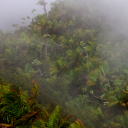Night in the forest – what is this tree, filling a gap in the canopy? Though it may look like something out of a Dr. Seuss book, it is actually Cecropia schreberiana, locally known as yagrumo. This is one of the more common species in the Neotropics, easily identified by its distinctive leaves: many lobes, with the petiole attached in the center (peltate), and with a velvety white underside. Each leaf is more than a foot wide – when one falls from the tree, an audible thud can be heard in the forest! The distinctive long branches and spindly trunk also help identify this species in the field.
So what makes this species so dominant? You can see it here on this hillslope, partitioning resources with Prestoea palms. Cecropia is a fast-growing species – quick to germinate, quick to reach towards the sun, tolerant of disturbed conditions. When other trees fall, Cecropia seedlings appear. When hurricanes destroy whole stands, Cecropia seedlings appear. When people clear forest and build roads or install fields, Cecropia appears. It is one of the ‘weeds’ of the forest, but without the normal negative connotations of that word. It is in some ways an ecosystem engineer, providing shade and soil stabilization that enable other species to later colonize a disturbed area.
Doesn’t it look like an imaginary tree? Evolution results in some marvelous natural forms…


